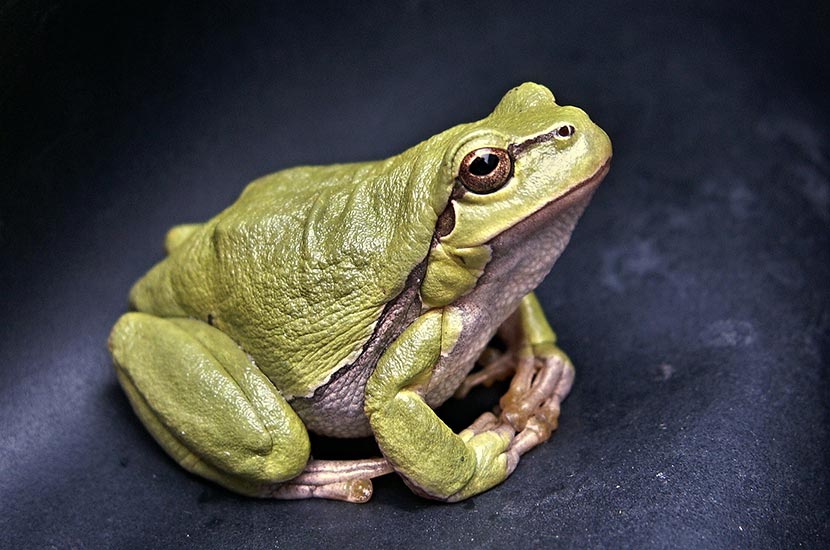Kristin Claricoates, DVM
Overview
Ranaviruses are viruses belong to the Iridoviridae family and the genus Ranavirus. Occasionally, amphibian ranaviruses are called iridoviruses rather than ranaviruses (which are different from the insect viruses called Iridovirus; insect iridovirus is not a ranavirus). Some of the isolates of amphibian ranaviruses have been named. It is thought that the viruses are passed by direct contact or cannibalism or through the water.
Ranaviruses cause massive die-offs of amphibians. These occur most commonly in mole salamanders (Ambystoma spp.), true frogs (Lithobates spp. and Rana spp.) and chorus frogs (Pseudacris spp.). Ranavirus infections in turtles occur mostly in captive colonies of eastern box turtles (Terrapene carolina carolina) and true tortoises. At present, ranavirus infections appear to be limited to ectothermic vertebrates. That is to say, any species of fish, amphibians (frogs & salamanders) and reptile (turtles & snakes) could be susceptible to the virus, although not all species have been documented with ranavirus. It appears that larvae and metamorphs are most affected. Adult morbidity and mortality occur less often. It is unclear how many strains or species of ranavirus are infecting and killing amphibians and turtles. As of 2013, ranavirus was known to infect more than 104 species and subspecies. The virus generally cannot be cultured at temperatures above 30ºC, so it probably is not infectious to domestic mammals and humans.
Symptoms
Clinical signs of disease can often be nonspecific, but affected individuals usually present with subtle to severe hemorrhages in the ventral skin, especially at the base of the hind limbs and around the vent opening and swelling of the legs and body. Hemorrhages may be present from tip of chin to tip of tail ventrally and may be pinpoint or irregular patches. White plaques in mouth, wheezing and swollen eyes may also be present in reptiles. Behavioral changes may include lethargy, anorexia and erratic swimming. Turtles with ranavirus infection show weakness, swollen eyelids, discharge from the nose and mouth, and the tongue and palate may show dull white or thick yellow plaques. Occasionally, turtles may show ulcers on the bottom of their feet. In general, the occurrence of an explosive mortality outbreak with signs of systemic hemorrhagic disease, or signs of chronic disease with skin ulceration and/or distal limb necrosis are potential indicators of infection with a ranavirus.
Prognosis
Ranaviruses are commonly lethal to larvae or young individuals, quickly spreading through populations that tend to congregate in large groups. Some amphibian populations can suffer up to 90% mortality. Adults can also become infected, but many are likely to survive the illness. However, once infected with ranavirus, the overall health of the amphibian may suffer and they can become more susceptible to other diseases and to depredation in the wild.
Transmission
The virus is primarily transmitted by contact between carriers of the virus and uninfected individuals. Humans may be the number one long-distance transmitters of ranavirus, due to our ability to travel great distances and visit many wetlands. Any animal or object that enters a wetland could potentially pick up and transmit the virus. The virus can then be passed to other individuals in the same wetland or be transported to other wetlands via the host’s movements. Depending on environmental conditions, the viruses can survive in water for several weeks outside the host, and for shorter periods of time under dry conditions. The virus is also transmitted through direct contact, cannibalism, and through the water skin ulceration.
Diagnosis
Diagnosis is made through any of the following diagnostic tests: PCR, real-time PCR, virus isolation (followed by immunofluorescence or immunohistochemistry), and/or histology (followed by immunofluorescence or immunohistochemistry)
Quarantine
If Ranavirus is diagnosed, the affected aquarium/terrarium should be quarantined and all amphibians affected should be isolated. Treatment should be initiated to prevent secondary bacterial infection and stress minimized. Tanks that have a quarantine and healthy tanks should have separate water sources. To clean these affected tanks, remove debris from the tank surfaces, then disinfect. Suggested disinfectant for housing facilities include Nolvasan (2%) and bleach (3%) for at least 1 minute. Rinse facilities well following disinfection.
Treatment
Medical management of the symptoms and preventing secondary bacterial infection and stress is the best treatment for a ranavirus; there are no specific drugs to kill a ranavirus nor is there a specific vaccination to protect against it. Euthanasia of particularly ill animals may be considered.
Should you wish to know more about ranaviruses, there is an international symposium on ranaviruses that occurs. Please check listings.
Works Cited
European Association of Zoos and Aquaria. EAZWV Transmissible Disease Fact Sheet Ranavirus Infections in Amphibians. 2011. 5 March 2015. <http://www.eaza.net/activities/tdfactsheets/050%20Ranavirus%20Infection%20In%20Amphibians.doc.pdf>.
Green, D. Earle. “Pathology of Amphibia.” Wright, Kevin M. and Brent R. Whitaker. Amphibian Medicine and Captive Husbandry. Malabar: Krieger Publishing Company, 2001. 418-419.
James F. X. Wellehan, Jr. “Iridovirus Infection.” Mayer, Jorg and Thomas M. Donnelly. Clinical Veterinary Advisor Birds and Exotic Pets. St. Louis: Elsevier, 2013. 114-115.
Miller, Debra Lee. “Ranavirus.” Mader, Douglas R. and Stephen J. Divers. Current Therapy in Reptile Medicine & Surgery. St. Louis: Elsevier, 2014. 277-280.
National Wildlife Health Center. “Ranavirus.” 21 May 2013. National Wildlife Health Center. 5 March 2015.
Northeast Partners in Amphibian and Reptile Conservation. Ranavirus Frequently Asked Questions. January 2014. 5 May 2015. <http://www.northeastparc.org/products/pdfs/NEPARC_Ranavirus_FAQ.pdf>.
OIE. “Infection With Ranavirus.” 2007. World Organisation for Animal Health. 5 March 2015.

